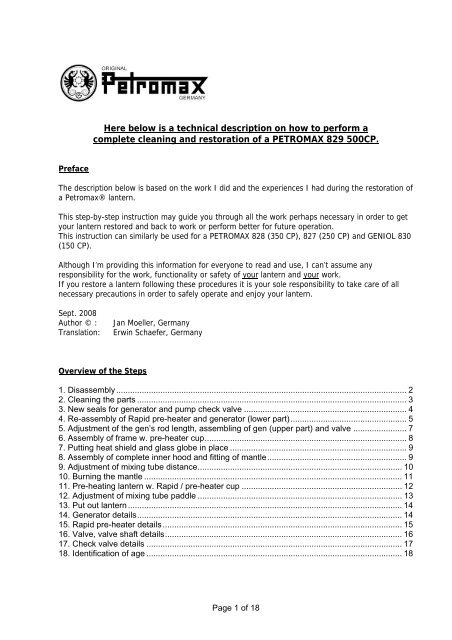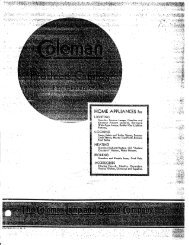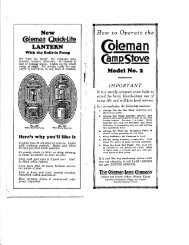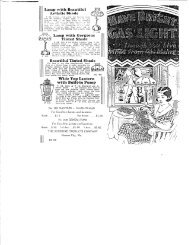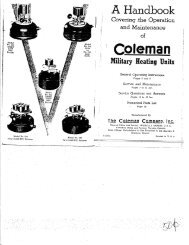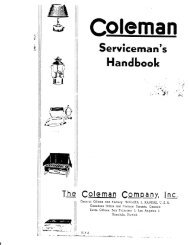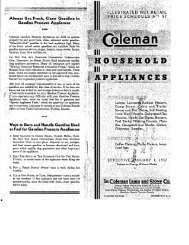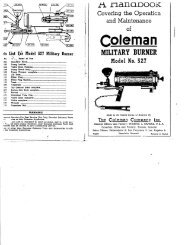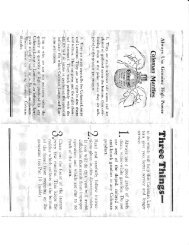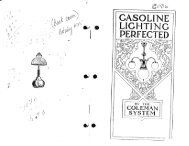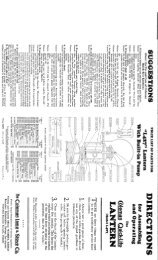Here below is a technical description on how to perform a complete ...
Here below is a technical description on how to perform a complete ...
Here below is a technical description on how to perform a complete ...
You also want an ePaper? Increase the reach of your titles
YUMPU automatically turns print PDFs into web optimized ePapers that Google loves.
Preface<br />
<str<strong>on</strong>g>Here</str<strong>on</strong>g> <str<strong>on</strong>g>below</str<strong>on</strong>g> <str<strong>on</strong>g>is</str<strong>on</strong>g> a <str<strong>on</strong>g>technical</str<strong>on</strong>g> <str<strong>on</strong>g>descripti<strong>on</strong></str<strong>on</strong>g> <strong>on</strong> <strong>how</strong> <strong>to</strong> <strong>perform</strong> a<br />
<strong>complete</strong> cleaning and res<strong>to</strong>rati<strong>on</strong> of a PETROMAX 829 500CP.<br />
The <str<strong>on</strong>g>descripti<strong>on</strong></str<strong>on</strong>g> <str<strong>on</strong>g>below</str<strong>on</strong>g> <str<strong>on</strong>g>is</str<strong>on</strong>g> based <strong>on</strong> the work I did and the experiences I had during the res<strong>to</strong>rati<strong>on</strong> of<br />
a Petromax® lantern.<br />
Th<str<strong>on</strong>g>is</str<strong>on</strong>g> step-by-step instructi<strong>on</strong> may guide you through all the work perhaps necessary in order <strong>to</strong> get<br />
your lantern res<strong>to</strong>red and back <strong>to</strong> work or <strong>perform</strong> better for future operati<strong>on</strong>.<br />
Th<str<strong>on</strong>g>is</str<strong>on</strong>g> instructi<strong>on</strong> can similarly be used for a PETROMAX 828 (350 CP), 827 (250 CP) and GENIOL 830<br />
(150 CP).<br />
Although I’m providing th<str<strong>on</strong>g>is</str<strong>on</strong>g> informati<strong>on</strong> for every<strong>on</strong>e <strong>to</strong> read and use, I can’t assume any<br />
resp<strong>on</strong>sibility for the work, functi<strong>on</strong>ality or safety of your lantern and your work.<br />
If you res<strong>to</strong>re a lantern following these procedures it <str<strong>on</strong>g>is</str<strong>on</strong>g> your sole resp<strong>on</strong>sibility <strong>to</strong> take care of all<br />
necessary precauti<strong>on</strong>s in order <strong>to</strong> safely operate and enjoy your lantern.<br />
Sept. 2008<br />
Author © : Jan Moeller, Germany<br />
Translati<strong>on</strong>: Erwin Schaefer, Germany<br />
Overview of the Steps<br />
1. D<str<strong>on</strong>g>is</str<strong>on</strong>g>assembly ............................................................................................................................. 2<br />
2. Cleaning the parts .................................................................................................................... 3<br />
3. New seals for genera<strong>to</strong>r and pump check valve ...................................................................... 4<br />
4. Re-assembly of Rapid pre-heater and genera<strong>to</strong>r (lower part).................................................. 5<br />
5. Adjustment of the gen’s rod length, assembling of gen (upper part) and valve ....................... 7<br />
6. Assembly of frame w. pre-heater cup....................................................................................... 8<br />
7. Putting heat shield and glass globe in place ............................................................................ 9<br />
8. Assembly of <strong>complete</strong> inner hood and fitting of mantle............................................................ 9<br />
9. Adjustment of mixing tube d<str<strong>on</strong>g>is</str<strong>on</strong>g>tance........................................................................................ 10<br />
10. Burning the mantle ............................................................................................................... 11<br />
11. Pre-heating lantern w. Rapid / pre-heater cup ..................................................................... 12<br />
12. Adjustment of mixing tube paddle ........................................................................................ 13<br />
13. Put out lantern ...................................................................................................................... 14<br />
14. Genera<strong>to</strong>r details.................................................................................................................. 14<br />
15. Rapid pre-heater details ....................................................................................................... 15<br />
16. Valve, valve shaft details...................................................................................................... 16<br />
17. Check valve details .............................................................................................................. 17<br />
18. Identificati<strong>on</strong> of age .............................................................................................................. 18<br />
Page 1 of 18
Remark:<br />
The part no’s. referred <strong>to</strong> in the following <str<strong>on</strong>g>descripti<strong>on</strong></str<strong>on</strong>g> are the standard part no’s. given by Petromax.<br />
These can be used e.g. for identifying parts or ordering replacement parts.<br />
1. D<str<strong>on</strong>g>is</str<strong>on</strong>g>assembly<br />
Pic. 1: Th<str<strong>on</strong>g>is</str<strong>on</strong>g> <str<strong>on</strong>g>is</str<strong>on</strong>g> the candidate for res<strong>to</strong>rati<strong>on</strong> before d<str<strong>on</strong>g>is</str<strong>on</strong>g>assembly.<br />
Start with the ventila<strong>to</strong>r (#123). Loosen the knurled nuts <strong>on</strong> the frame (#121) until the ventila<strong>to</strong>r<br />
can be lifted and removed. After th<str<strong>on</strong>g>is</str<strong>on</strong>g> the inner hood (#117) can be taken out. Make sure the<br />
ceramic burner <str<strong>on</strong>g>is</str<strong>on</strong>g> not damaged when setting aside.<br />
Now take the glass globe (#74) and the heat shield (if fitted) out. Remove the centre bot<strong>to</strong>m screw<br />
(#14) which fixes the centre bot<strong>to</strong>m plate <strong>to</strong> the f<strong>on</strong>t with a flat screwdriver. Next, take the centre<br />
bot<strong>to</strong>m plate (#122) out and set the <strong>complete</strong> frame aside.<br />
The f<strong>on</strong>t (#120) with the attached parts <str<strong>on</strong>g>is</str<strong>on</strong>g> left now.<br />
The Rapid pre-heater (#226) <str<strong>on</strong>g>is</str<strong>on</strong>g> d<str<strong>on</strong>g>is</str<strong>on</strong>g>assembled as follows: Open the pre-heater lever (#223), pull the<br />
flame tube (#220) off, unscrew the nozzle (#221) and the pre-heater nut (#222). The lever<br />
(#223) can now be removed. Finally unscrew the pre-heater body (#225) and put all parts aside.<br />
To d<str<strong>on</strong>g>is</str<strong>on</strong>g>assemble the genera<strong>to</strong>r, remove the nozzle (#115) with a 9mm wrench (or Petromax®<br />
wrench or adjustable wrench), then take the needle (#68) out with the special <strong>to</strong>ol (see pic. 13).<br />
Unscrew the gland nut of the gen’s upper part (#152) using a proper wrench and lift the upper part<br />
off of the gen. rod (#104). Now unscrew the <strong>complete</strong> valve (#114) with a 10mm (or equivalent)<br />
wrench. One now can take the <strong>complete</strong> genera<strong>to</strong>r rod (#104) out. Unscrew the gen’s lower part<br />
(#153) from the f<strong>on</strong>t (#120).<br />
Page 2 of 18
To <strong>complete</strong> the d<str<strong>on</strong>g>is</str<strong>on</strong>g>assembly remove the <strong>complete</strong> pressure gauge set (#149). Remove the pump<br />
(#6) <strong>to</strong> get access <strong>to</strong> the pump check valve (#10). Take the valve out with a big, flat screwdriver or<br />
the special check valve <strong>to</strong>ol (#57) depending <strong>on</strong> the type of valve.<br />
C<strong>on</strong>gratulati<strong>on</strong>s!<br />
You are now d<strong>on</strong>e with d<str<strong>on</strong>g>is</str<strong>on</strong>g>assembly.<br />
2. Cleaning the parts<br />
Pic. 2: Lantern <strong>complete</strong>ly d<str<strong>on</strong>g>is</str<strong>on</strong>g>assembled in<strong>to</strong> parts.<br />
After the above procedure and a first inspecti<strong>on</strong> of the parts, I heated water in a bucket for washing<br />
and added some citric acid.<br />
I prepared myself with protective gloves and goggles and started off with an old <strong>to</strong>othbrush as the<br />
best and cheapest <strong>to</strong>ol <strong>to</strong> clean the small parts and folds, where it <str<strong>on</strong>g>is</str<strong>on</strong>g> difficult <strong>to</strong> get access <strong>to</strong>.<br />
Most of the dirt and debr<str<strong>on</strong>g>is</str<strong>on</strong>g> came off of the parts quite fast in the hot citric soluti<strong>on</strong>.<br />
After I’d cleaned the f<strong>on</strong>t, frame, centre bot<strong>to</strong>m plate and the ventila<strong>to</strong>r I washed the parts again in<br />
water with d<str<strong>on</strong>g>is</str<strong>on</strong>g>h detergent added in order <strong>to</strong> s<strong>to</strong>p the chemical reacti<strong>on</strong> of the citric acid.<br />
The other parts like gen and pre-heater were specially cleaned in an ultras<strong>on</strong>ic bath with citric acid<br />
again. They came out very nice and clean.<br />
However, the brass changed the color in the citric acid <strong>to</strong> a redd<str<strong>on</strong>g>is</str<strong>on</strong>g>h t<strong>on</strong>e because small particles of<br />
zinc are c<strong>on</strong>sumed in the bath and the copper shines up more. I pol<str<strong>on</strong>g>is</str<strong>on</strong>g>hed those parts with fine steel<br />
wool and they now shine nicely in the original brass t<strong>on</strong>e again.<br />
Page 3 of 18
Pic. 3: The bucket with the main parts in citric acid<br />
Pic. 4: F<strong>on</strong>t, already partly cleaned Pic. 5: The cleaned vent<br />
3. New seals for genera<strong>to</strong>r and pump check valve<br />
Usually the rubber seals in the genera<strong>to</strong>r foot valve (#196) and the pump check valve (#10) are dry<br />
and <strong>to</strong>tally hardened. If <strong>on</strong>e doesn’t at least replace the pump check valve seal <strong>on</strong>e can hardly<br />
operate the lantern safely because of kero leaking from the f<strong>on</strong>t in<strong>to</strong> the pump body, thus flooding<br />
the body and also losing pressure.<br />
An old, hardened seal in the genera<strong>to</strong>r foot (#193) must in any case be replaced if <strong>on</strong>e wants <strong>to</strong><br />
pre-heat the lantern with the Rapid pre-heater later. If <strong>on</strong>e <strong>on</strong>ly wants <strong>to</strong> pre-heat using the little<br />
alcohol cup (#35) then it <str<strong>on</strong>g>is</str<strong>on</strong>g> not manda<strong>to</strong>ry but again highly recommended for safety reas<strong>on</strong>s.<br />
The <strong>complete</strong> pump check valve <str<strong>on</strong>g>is</str<strong>on</strong>g> s<strong>how</strong>n in pic. 6. The rubber seal (#17) needs <strong>to</strong> be replaced. The<br />
lead washer (#83) should also be replaced. However, if it doesn’t have <strong>to</strong>o much deformati<strong>on</strong> you<br />
can try <strong>to</strong> re-use it, but make sure it seals tightly and doesn’t leak.<br />
In case of any lead washer make sure you turn the parts <strong>on</strong>ly clockw<str<strong>on</strong>g>is</str<strong>on</strong>g>e <strong>to</strong> keep the lead washer<br />
tight. Never turn counter-clockw<str<strong>on</strong>g>is</str<strong>on</strong>g>e again!<br />
Page 4 of 18
The most comm<strong>on</strong> problems are caused by a defective / leaky genera<strong>to</strong>r foot valve.<br />
When the f<strong>on</strong>t <str<strong>on</strong>g>is</str<strong>on</strong>g> pressurized, the valve wheel points <strong>to</strong> the ‘closed’ positi<strong>on</strong> and <strong>on</strong>e starts <strong>to</strong> preheat<br />
the gen with the Rapid pre-heater, then some fuel might r<str<strong>on</strong>g>is</str<strong>on</strong>g>e in the gen and come out of the<br />
nozzle. Th<str<strong>on</strong>g>is</str<strong>on</strong>g> causes the lantern <strong>to</strong> catch fire with lots of smoke and soot. If that c<strong>on</strong>tinues during the<br />
pre-heating time <strong>on</strong>e has a perfect ‘inferno’.<br />
Pic. 7 s<strong>how</strong>s secti<strong>on</strong>s of the gen’s lower part (#153), the genera<strong>to</strong>r rod (#104) as well as the<br />
d<str<strong>on</strong>g>is</str<strong>on</strong>g>assembled genera<strong>to</strong>r foot valve with the rubber seal (#193) and the valve spring (#194).<br />
#83 #153 #104 #193<br />
Pic. 6: Pump check valve Pic. 7: Genera<strong>to</strong>r foot valve<br />
Everything fine so far?<br />
#17<br />
All parts clean, straightened-out, worn-out parts replaced and seals at hand <strong>to</strong> start reassembling?<br />
OK, fine! Then let’s go for the next step.<br />
4. Re-assembly of Rapid pre-heater and genera<strong>to</strong>r (lower part)<br />
In general, re-assembly of the whole lantern <str<strong>on</strong>g>is</str<strong>on</strong>g> d<strong>on</strong>e in the reverse sequence compared <strong>to</strong><br />
d<str<strong>on</strong>g>is</str<strong>on</strong>g>assembly.<br />
We’ll start with the Rapid pre-heater.<br />
First make sure the mesh (#187) at the lower end of the pick-up tube <str<strong>on</strong>g>is</str<strong>on</strong>g> clean. Otherw<str<strong>on</strong>g>is</str<strong>on</strong>g>e replace<br />
(see pic. 41).<br />
Also clean the tiny channels in the Rapid nozzle (centre hole for kero, 2 outer holes for air). Th<str<strong>on</strong>g>is</str<strong>on</strong>g> <str<strong>on</strong>g>is</str<strong>on</strong>g><br />
very important <strong>to</strong> get the Rapid running properly (see also pic. 42).<br />
The pre-heater body (#225) al<strong>on</strong>g with a new lead washer (#90) will be mounted first (pic. 8).<br />
Screw the part in until it sits tight and <str<strong>on</strong>g>is</str<strong>on</strong>g> properly adjusted. D<strong>on</strong>’t turn in reverse directi<strong>on</strong> again in<br />
order <strong>to</strong> avoid the lead washer leaking.<br />
Next, the lever (#223) <str<strong>on</strong>g>is</str<strong>on</strong>g> mounted <strong>on</strong><strong>to</strong> the pre-heater body. The lever <str<strong>on</strong>g>is</str<strong>on</strong>g> <strong>to</strong> be secured with the nut<br />
(#222). Now the pre-heater nozzle (#221) must be screwed <strong>on</strong><strong>to</strong> the pre-heater body. Then the<br />
flame pipe (#220) can be put <strong>on</strong><strong>to</strong> the nozzle (One can also put the flame pipe <strong>on</strong> after assembly of<br />
the frame).<br />
Most probably the rubber sealing part (#229, circled in pic. 9) has <strong>to</strong> be replaced as well as it <str<strong>on</strong>g>is</str<strong>on</strong>g><br />
worn out or edges are damaged due <strong>to</strong> improper centering.<br />
Page 5 of 18
Pic. 8: Pre-heater body Pic. 9. Lever and nozzle Pic.10: Completed<br />
Next <str<strong>on</strong>g>is</str<strong>on</strong>g> the re-assembly of genera<strong>to</strong>r (lower part).<br />
First comes the gen’s lower part (#152) and a lead washer (#90). The lead washer gets between<br />
the f<strong>on</strong>t and the lower part as s<strong>how</strong>n in the picture.<br />
It might be helpful <strong>to</strong> first screw in the gen without the lead washer <strong>to</strong> check the number of turns.<br />
Then put the washer <strong>on</strong> and screw in. Again, make sure you turn <strong>on</strong>ly clockw<str<strong>on</strong>g>is</str<strong>on</strong>g>e until the gen <str<strong>on</strong>g>is</str<strong>on</strong>g> in<br />
the right positi<strong>on</strong> <strong>to</strong> avoid leakages from the lead washer later.<br />
The opening for the valve w. the valve wheel (#114) should then exactly point <strong>to</strong> the fr<strong>on</strong>t<br />
(outwards). Only then can <strong>on</strong>e assemble the frame easily and correctly later.<br />
Pic. 11: Lower part of gen w. lead washer<br />
Page 6 of 18
5. Adjustment of the gen’s rod length, assembling of gen (upper part) and valve<br />
In order <strong>to</strong> <strong>complete</strong> the re-installati<strong>on</strong> of the genera<strong>to</strong>r, <strong>on</strong>e now has <strong>to</strong> put the genera<strong>to</strong>r rod<br />
(#104) in place. The rod <str<strong>on</strong>g>is</str<strong>on</strong>g> <strong>to</strong> be inserted in the gen’s body and turned in a way, that the receiver<br />
(#103) for the valve shaft (#105) can be seen through the gen’s valve opening (pic. 12).<br />
Now the valve shaft al<strong>on</strong>g with the hand wheel must be screwed in. In order <strong>to</strong> allow the little pin<br />
<strong>on</strong> the valve shaft <strong>to</strong> match the receiver (#103) <strong>on</strong>e needs <strong>to</strong> push down the gen rod a little. If that<br />
was d<strong>on</strong>e properly, <strong>on</strong>e can now move the rod up and down by turning the hand wheel.<br />
Next the upper part of the gen (#152) <str<strong>on</strong>g>is</str<strong>on</strong>g> carefully slid over the gen rod. Tighten the gland nut of<br />
the upper part ‘hand-tight’ <strong>on</strong>ly for now.<br />
Now take the thin gen needle (#68) and screw it in<strong>to</strong> the gen rod, using the special <strong>to</strong>ol (#119).<br />
See pic. 13. Finally insert the nozzle (#50) in<strong>to</strong> the gen and tighten loosely.<br />
Most important now <str<strong>on</strong>g>is</str<strong>on</strong>g> <strong>to</strong> check, <strong>how</strong> far the needle comes out of the gen’ nozzle when the valve <str<strong>on</strong>g>is</str<strong>on</strong>g><br />
closed (arrow <strong>on</strong> the hand wheel points ‘up’). It’s best if the needle comes out between 0.5 – 1mm.<br />
If it comes out c<strong>on</strong>siderably more or less, a re-adjustment <str<strong>on</strong>g>is</str<strong>on</strong>g> necessary. It shouldn’t look like as<br />
s<strong>how</strong>n in pic. 14.<br />
If a re-adjustment <str<strong>on</strong>g>is</str<strong>on</strong>g> required, unscrew the gen’s nozzle again, followed by the needle. Next the<br />
gen’s upper part and the valve with hand wheel have <strong>to</strong> come out again.<br />
The 2 halves of the genera<strong>to</strong>r rod need <strong>to</strong> be adjusted <strong>to</strong> a proper length so that the above<br />
menti<strong>on</strong>ed measures (0.5-1mm) are reached. To achieve th<str<strong>on</strong>g>is</str<strong>on</strong>g>, the little counter nut (#102) <strong>on</strong> the<br />
‘recepti<strong>on</strong> part’ has <strong>to</strong> be loosened, the length adjusted and the nut pulled tight again (pic. 15 and<br />
16).<br />
When that step has been d<strong>on</strong>e successfully, all parts need <strong>to</strong> be re-assembled as described above.<br />
Now check all c<strong>on</strong>necti<strong>on</strong>s again and pull firmly tight in order <strong>to</strong> safely run the lantern and avoid<br />
leakages during later operati<strong>on</strong>.<br />
In the optimum case the needle looks out of the nozzle as s<strong>how</strong>n in pic. 17.<br />
If a proper result was not achieved in a first step, <strong>on</strong>e unfortunately has <strong>to</strong> repeat the whole<br />
procedure until a c<strong>on</strong>venient result <str<strong>on</strong>g>is</str<strong>on</strong>g> achieved.<br />
Pic. 12: valve assembly Pic. 13: needle mounting Pic. 14: No proper adjustm.<br />
Page 7 of 18
Pic. 15: Adjustment of rod’s length Pic. 16: Secure adjustment w. counter nut<br />
Pic. 17: Proper adjustment<br />
6. Assembly of frame w. pre-heater cup<br />
Now it’s time <strong>to</strong> assemble the frame (#121).<br />
Set the frame <strong>on</strong><strong>to</strong> the f<strong>on</strong>t and adjust right. Put the centre bot<strong>to</strong>m plate (#122) in the bot<strong>to</strong>m of<br />
the frame and fix these parts using the centre bot<strong>to</strong>m screw (#14). If the lantern <str<strong>on</strong>g>is</str<strong>on</strong>g>n’t already fitted<br />
with an alcohol pre-heater cup (#35) th<str<strong>on</strong>g>is</str<strong>on</strong>g> <str<strong>on</strong>g>is</str<strong>on</strong>g> the time <strong>to</strong> add <strong>on</strong>e. Just put in <strong>on</strong> <strong>to</strong>p of the centre<br />
bot<strong>to</strong>m plate and screw all parts <strong>to</strong>gether. You now have the opti<strong>on</strong>s <strong>to</strong> pre-heat using the Rapid<br />
pre-heater or make a softer start with alcohol.<br />
Pic. 18: Centre bot<strong>to</strong>m plate, centre screw Pic. 19: Completely assembled<br />
and pre-heater cup<br />
Page 8 of 18
7. Putting heat shield and glass globe in place<br />
Now the glass globe (#74) can be set in. Opti<strong>on</strong>ally <strong>on</strong>e can also add a heat shield (# 126). Th<str<strong>on</strong>g>is</str<strong>on</strong>g><br />
heat shield protects the f<strong>on</strong>t from heat radiating down from the mantle. However, it <str<strong>on</strong>g>is</str<strong>on</strong>g> still possible <strong>to</strong><br />
pre-heat the gen using the alcohol pre-heater cup, if desired.<br />
There are <str<strong>on</strong>g>descripti<strong>on</strong></str<strong>on</strong>g>s in old ads that <strong>on</strong>e can run a lantern with fitted heat shield for some more<br />
time even if the mantle <str<strong>on</strong>g>is</str<strong>on</strong>g> broken. However, I can’t recommend th<str<strong>on</strong>g>is</str<strong>on</strong>g> as the glass globe <str<strong>on</strong>g>is</str<strong>on</strong>g> at r<str<strong>on</strong>g>is</str<strong>on</strong>g>k.<br />
Replace a broken mantle as so<strong>on</strong> as you notice.<br />
Pic. 20: Fitted heat shield and globe<br />
8. Assembly of <strong>complete</strong> inner hood and fitting of mantle<br />
The <strong>complete</strong> inner hood c<strong>on</strong>s<str<strong>on</strong>g>is</str<strong>on</strong>g>ts of the following parts: The inner hood (#117) itself, mixing tube<br />
(#33), mixing chamber (#34) and the ceramic burner (#3). See pic. 21 and 22.<br />
These three parts are adjusted and held in place by the clip (#20), screw (#21) and cross bar<br />
(#22).<br />
The mantle <str<strong>on</strong>g>is</str<strong>on</strong>g> put <strong>on</strong> the ceramic burner above the lower rim and roughly fixed with <strong>on</strong>e knot. Then<br />
the folds are d<str<strong>on</strong>g>is</str<strong>on</strong>g>tributed evenly, the knot <str<strong>on</strong>g>is</str<strong>on</strong>g> pulled tight and secured with a sec<strong>on</strong>d knot. Th<str<strong>on</strong>g>is</str<strong>on</strong>g><br />
ensures that the mantle will get an even form when burned. Now just cut the surplus strings off and<br />
you’re prepared (pic. 23).<br />
#34<br />
#33<br />
#35<br />
Pic. 21: Burner parts Pic. 22: Fixati<strong>on</strong> of mixing pipe Pic. 23: Mantle <strong>on</strong><br />
Page 9 of 18<br />
#117<br />
#22<br />
Fitted heat shield
9. Adjustment of mixing tube d<str<strong>on</strong>g>is</str<strong>on</strong>g>tance<br />
The generati<strong>on</strong> of best (kero-) gas / air mixture <str<strong>on</strong>g>is</str<strong>on</strong>g> ensured by the proper adjustment of the mixing<br />
tube d<str<strong>on</strong>g>is</str<strong>on</strong>g>tance. The inner hood must firmly sit <strong>on</strong> the frame before adjustment. The valve must be in<br />
the ‘open’ positi<strong>on</strong> (arrow pointing down) <strong>to</strong> avoid bending of the genera<strong>to</strong>r needle sticking out of<br />
the nozzle with the Petromax wrench (#66).<br />
Loosen the screw (#21) a little with a flat screwdriver until the mixing tube can be moved up (see<br />
pic. 24). Now place the Petromax wrench vertically <strong>on</strong> <strong>to</strong>p of the nozzle and slide it in the ‘500CP’<br />
positi<strong>on</strong> (pic. 25). Now lower the mixing chamber <strong>on</strong><strong>to</strong> the wrench.<br />
Pull the screw (#21) securely tight, check the d<str<strong>on</strong>g>is</str<strong>on</strong>g>tance again and the proper d<str<strong>on</strong>g>is</str<strong>on</strong>g>tance <str<strong>on</strong>g>is</str<strong>on</strong>g> adjusted<br />
and fixed. The optimum value for a 500cP lantern <str<strong>on</strong>g>is</str<strong>on</strong>g> 14.2mm.<br />
Pic. 24: Inner hood details Pic. 25: Adjusting the mixing tube d<str<strong>on</strong>g>is</str<strong>on</strong>g>tance<br />
C<strong>on</strong>gratulati<strong>on</strong>s again!<br />
By now all the preparati<strong>on</strong> work <str<strong>on</strong>g>is</str<strong>on</strong>g> pretty much d<strong>on</strong>e.<br />
Now fill the f<strong>on</strong>t with max. <strong>on</strong>e liter of clean, white kerosene. Th<str<strong>on</strong>g>is</str<strong>on</strong>g> ensures that the necessary space<br />
<str<strong>on</strong>g>is</str<strong>on</strong>g> left in the f<strong>on</strong>t for pressurizing. If the f<strong>on</strong>t <str<strong>on</strong>g>is</str<strong>on</strong>g> overfilled <strong>on</strong>e has <strong>to</strong> pump again within a very short<br />
time <strong>to</strong> maintain required pressure.<br />
When d<strong>on</strong>e, screw the pressure gauge set (#149) tightly <strong>on</strong>. Make sure the rubber gauge seal<br />
(#11) <str<strong>on</strong>g>is</str<strong>on</strong>g> there and it’s undamaged.<br />
Pic. 26: Fill up with clean kero<br />
Page 10 of 18
10. Burning the mantle<br />
The lantern <str<strong>on</strong>g>is</str<strong>on</strong>g> now prepared. Now open (!) the pressure relieve screw of the pressure gauge.<br />
It’s adv<str<strong>on</strong>g>is</str<strong>on</strong>g>able <strong>to</strong> burn the mantle outdoors as it generates str<strong>on</strong>g fumes and odor.<br />
Fill the pre-heater cup with alcohol (Ethanol) and light. The mantle starts <strong>to</strong> burn or glow until<br />
<strong>complete</strong>ly burned white. Only now it’s ready <strong>to</strong> use. If it doesn’t burn <strong>complete</strong>ly put some more<br />
alcohol in the cup and c<strong>on</strong>tinue.<br />
Burning the mantle with the Rapid (in case of n<strong>on</strong>-ex<str<strong>on</strong>g>is</str<strong>on</strong>g>ting alcohol cup) <str<strong>on</strong>g>is</str<strong>on</strong>g> different.<br />
<str<strong>on</strong>g>Here</str<strong>on</strong>g> the valve and the pressure relieve screw <strong>on</strong> the pressure gauge must be closed. Pump the f<strong>on</strong>t<br />
up <strong>to</strong> a lower pressure, just enough <strong>to</strong> get the Rapid <strong>to</strong> burn. Now open the Rapid with the lever<br />
and light the gas stream with a lighter or small gas burner. Let the mantle burn until <strong>complete</strong>ly<br />
white.<br />
A properly burned mantle should look as seen in pic. 31 <str<strong>on</strong>g>below</str<strong>on</strong>g>.<br />
After burning let the mantle set and cool down some time before lighting the lantern.<br />
Pic. 27: Filling alcohol in the cup w. bottle Pic. 28: Burning the mantle<br />
Pic. 29: Pump up <strong>to</strong> suitable pressure Pic. 30: Ignite Pic. 31: Nicely burned<br />
Page 11 of 18<br />
Ignite<br />
here
11. Pre-heating lantern w. Rapid / pre-heater cup<br />
Pre-heating the genera<strong>to</strong>r before lighting the lantern can be d<strong>on</strong>e in two ways:<br />
1) w. Rapid pre-heater using kero from the f<strong>on</strong>t, or<br />
2) w. pre-heater cup and alcohol.<br />
For pre-heating with the Rapid <strong>on</strong>e has <strong>to</strong> pressurize the f<strong>on</strong>t first. Close the valve (arrow ‘up’) and<br />
the pressure relieve screw <strong>on</strong> the pressure gauge (#149). Pump up until the pressure <str<strong>on</strong>g>is</str<strong>on</strong>g> between 1<br />
… 1.5 bar. Usually the Rapid pre-heater works best in that range.<br />
Now open the Rapid lever and immediately light the kero / air mixture (see pic. 30). Sometimes the<br />
pressure from the nozzle blows the Rapid out by itself. Then try again with some higher or lower<br />
pressure.<br />
When the Rapid <str<strong>on</strong>g>is</str<strong>on</strong>g> firing (pic. 32; d<strong>on</strong>’t be afraid, it’s quite no<str<strong>on</strong>g>is</str<strong>on</strong>g>y), c<strong>on</strong>stantly watch the pressure and<br />
keep slowly pumping <strong>to</strong> maintain a suitable pressure level in the f<strong>on</strong>t.<br />
Pre-heat for abt. 60-90 sec<strong>on</strong>ds and make sure the flame reaches the upper part of the gen and the<br />
c<strong>on</strong>necti<strong>on</strong>s <strong>to</strong> the genera<strong>to</strong>r loop (pic. 33).<br />
Now slowly open the valve. As so<strong>on</strong> as the mantle starts <strong>to</strong> form and <strong>to</strong> give a bright light (pic. 34),<br />
flip the Rapid lever down.<br />
Check that the little rubber seal securely tightens the pre-heater nozzle (pic. 9).<br />
Let the lantern run with lower pressure for a short time, watch the lantern behaviour (tightness etc.)<br />
and check, if the mantle <str<strong>on</strong>g>is</str<strong>on</strong>g> not damaged. Use welder’s goggles or dark glass (pic. 35).<br />
Pre-heating with alcohol takes more time but <str<strong>on</strong>g>is</str<strong>on</strong>g> a ‘softer’ start and <str<strong>on</strong>g>is</str<strong>on</strong>g> more gentle <strong>to</strong> the mantle.<br />
In th<str<strong>on</strong>g>is</str<strong>on</strong>g> case the valve and pressure release screw might be kept open. The pre-heater cup must be<br />
filled with alcohol and lit. If the burning time <str<strong>on</strong>g>is</str<strong>on</strong>g> c<strong>on</strong>siderably less than menti<strong>on</strong>ed above, the gen <str<strong>on</strong>g>is</str<strong>on</strong>g><br />
most probably not hot enough and a sec<strong>on</strong>d fill <str<strong>on</strong>g>is</str<strong>on</strong>g> required.<br />
Before the alcohol <str<strong>on</strong>g>is</str<strong>on</strong>g> fully burned, close the pressure release screw <strong>on</strong> the pressure gauge and start<br />
pumping <strong>to</strong> a suitable pressure. Slowly open the valve and let the rest of the burning alcohol light<br />
the lantern.<br />
Let the lantern run with lower pressure again and watch proper operati<strong>on</strong> before adding pressure up<br />
<strong>to</strong> the red mark <strong>on</strong> the pressure gauge.<br />
Pic. 32: Rapid firing Pic. 33: …<strong>to</strong> gen’s <strong>to</strong>p Pic. 34: Burning ok Pic. 35: Check mantle<br />
Page 12 of 18
12. Adjustment of mixing tube paddle<br />
Put the ventila<strong>to</strong>r <strong>on</strong> if not already d<strong>on</strong>e and make sure, the little screw in the mixing tube can be<br />
seen from outside. Otherw<str<strong>on</strong>g>is</str<strong>on</strong>g>e turn the vent horiz<strong>on</strong>tally by 180 degrees.<br />
Now, <strong>on</strong>ly the final tuning <str<strong>on</strong>g>is</str<strong>on</strong>g> left. Th<str<strong>on</strong>g>is</str<strong>on</strong>g> <str<strong>on</strong>g>is</str<strong>on</strong>g> d<strong>on</strong>e using the mixing tube ‘paddle’ inside of the mixing<br />
tube (#33). Now turn the screw with a flat screwdriver forward and backward until the lantern gives<br />
the brightest light (pic. 36).<br />
That’s it folks!<br />
Pic. 36: Adjusting the mixing tube ‘paddle’<br />
Pic. 37: Voila, the perfect result ! ☺<br />
Page 13 of 18
13. Put out lantern<br />
To put the lantern out, simply close the valve. If the genera<strong>to</strong>r foot valve was properly maintained<br />
and <str<strong>on</strong>g>is</str<strong>on</strong>g> tight, the lantern should s<strong>to</strong>p delivering fuel, vaporize the remaining fuel in the gen and go<br />
out almost immediately.<br />
The pressure can be kept in the f<strong>on</strong>t if <strong>on</strong>e wants <strong>to</strong> resume operati<strong>on</strong> very so<strong>on</strong>. However the<br />
lantern should be checked for leakages or dripping frequently.<br />
If it’s not going <strong>to</strong> be used in the very near future it’s best <strong>to</strong> put it out by just fully opening the<br />
pressure relieve screw <strong>on</strong> the pressure gauge. The lantern will dim and go out within a few sec<strong>on</strong>ds.<br />
Let the lantern cool down, close the main valve, screw the release screw tight again and s<strong>to</strong>re away.<br />
14. Genera<strong>to</strong>r details<br />
<str<strong>on</strong>g>Here</str<strong>on</strong>g> <str<strong>on</strong>g>below</str<strong>on</strong>g> some detail pictures of the genera<strong>to</strong>r parts:<br />
Pic. 38: Complete genera<strong>to</strong>r with rod, foot valve, main valve and nozzle with needle<br />
Pic. 39: Upper part of gen with Pic. 40: Lower part of gen w. gen rod<br />
nozzle and needle foot valve body, spring and seal<br />
Page 14 of 18
15. Rapid pre-heater details<br />
Some more pictures of the Rapid <strong>to</strong>rch pre-heater:<br />
Pic. 41: Fully assembled Rapid<br />
Pic. 42: D<str<strong>on</strong>g>is</str<strong>on</strong>g>assembled<br />
Pic. 43: Rapid details<br />
Kero hole in centre,<br />
2 outer air holes<br />
Page 15 of 18<br />
# 187 (mesh)
16. Valve, valve shaft details<br />
Pic. 44: The valve <strong>complete</strong>ly d<str<strong>on</strong>g>is</str<strong>on</strong>g>assembled Pic. 46: Completety assembled<br />
Pic. 45: A new graphite packing (#108) fitted<br />
Pic. 47: Valve wheel in ‘open’ positi<strong>on</strong> Pic. 48: Valve wheel in ‘closed’ positi<strong>on</strong><br />
Page 16 of 18
17. Check valve details<br />
Pic. 49: Pump check valve d<str<strong>on</strong>g>is</str<strong>on</strong>g>assembled Pic. 50: View in<strong>to</strong> the pump body<br />
Pic. 51: Pump, pump body and pump check valve<br />
Page 17 of 18
18. Identificati<strong>on</strong> of age<br />
The manufacturing date, for some lanterns, can be found according <strong>to</strong> the four-digit no. <strong>on</strong> the<br />
bot<strong>to</strong>m of the fount. However, as far as we know <strong>to</strong>day th<str<strong>on</strong>g>is</str<strong>on</strong>g> <str<strong>on</strong>g>is</str<strong>on</strong>g> valid <strong>on</strong>ly for lanterns made in the<br />
1960’s.<br />
My lantern bears the no. 4385.<br />
The first two digits refer <strong>to</strong> the week the lantern was made. <str<strong>on</strong>g>Here</str<strong>on</strong>g> it means week 43.<br />
The number 8 refers <strong>to</strong> the year: 8 means 1968.<br />
The 5 refers <strong>to</strong> the day in the week: 5 th day means Friday.<br />
From th<str<strong>on</strong>g>is</str<strong>on</strong>g> it seems the lantern was made Friday, Oct.25 th 1968.<br />
Th<str<strong>on</strong>g>is</str<strong>on</strong>g> way of identificati<strong>on</strong> <str<strong>on</strong>g>is</str<strong>on</strong>g> valid <strong>on</strong>ly for the ‘civil’ Petromax lanterns. Lanterns made for the army<br />
(with the dull grey surface) d<strong>on</strong>’t carry such numbers.<br />
Newer lanterns also have certain numbering but there <str<strong>on</strong>g>is</str<strong>on</strong>g> no valid and proven interpretati<strong>on</strong> up <strong>to</strong><br />
now.<br />
Pic. 52: The number <strong>on</strong> the bot<strong>to</strong>m of the fount<br />
That was it!<br />
My way and my experience during res<strong>to</strong>rati<strong>on</strong> of a Petromax lantern.<br />
Enjoy and run your lantern safely.<br />
© Jan Moeller 2008<br />
Page 18 of 18


